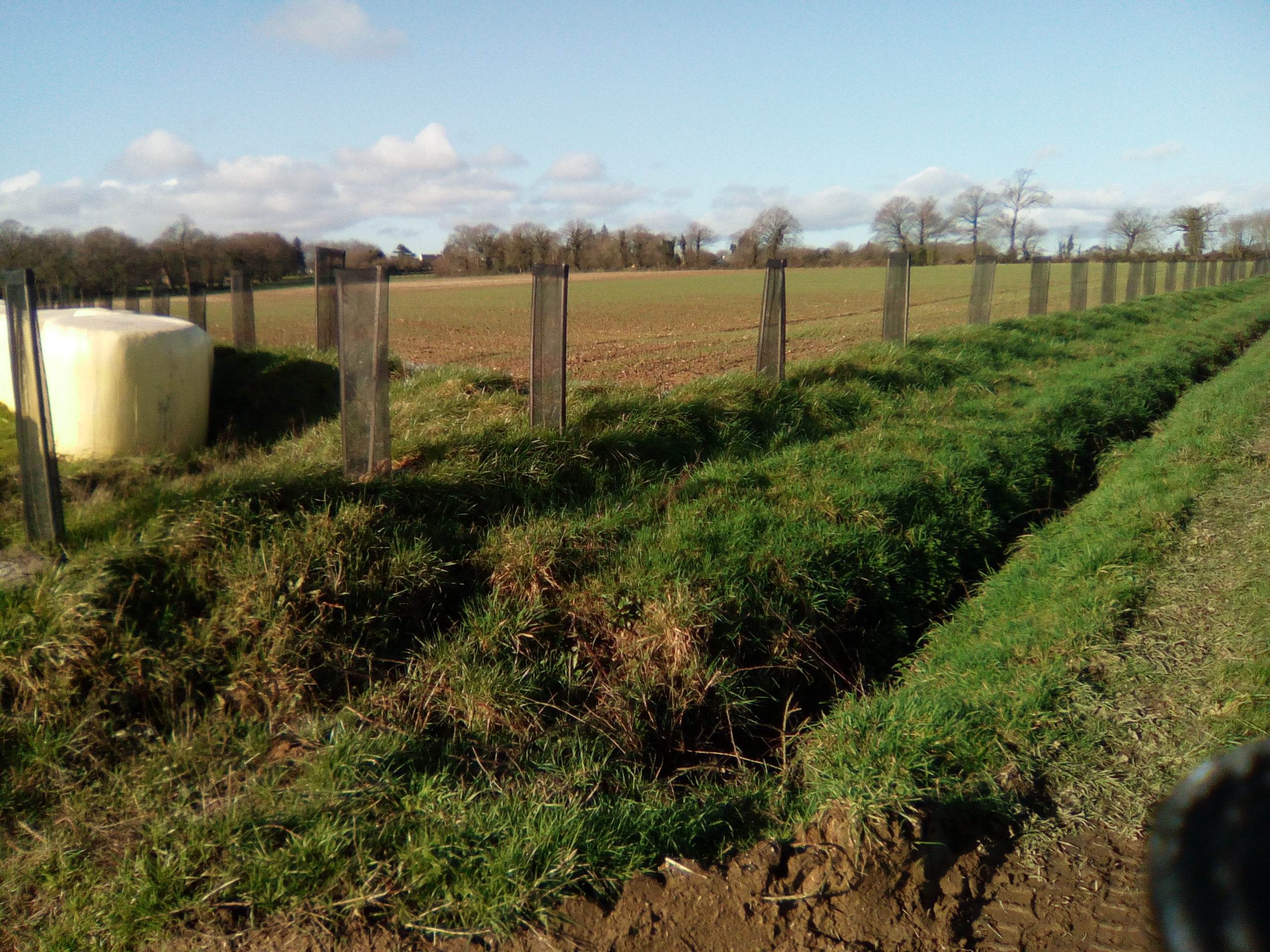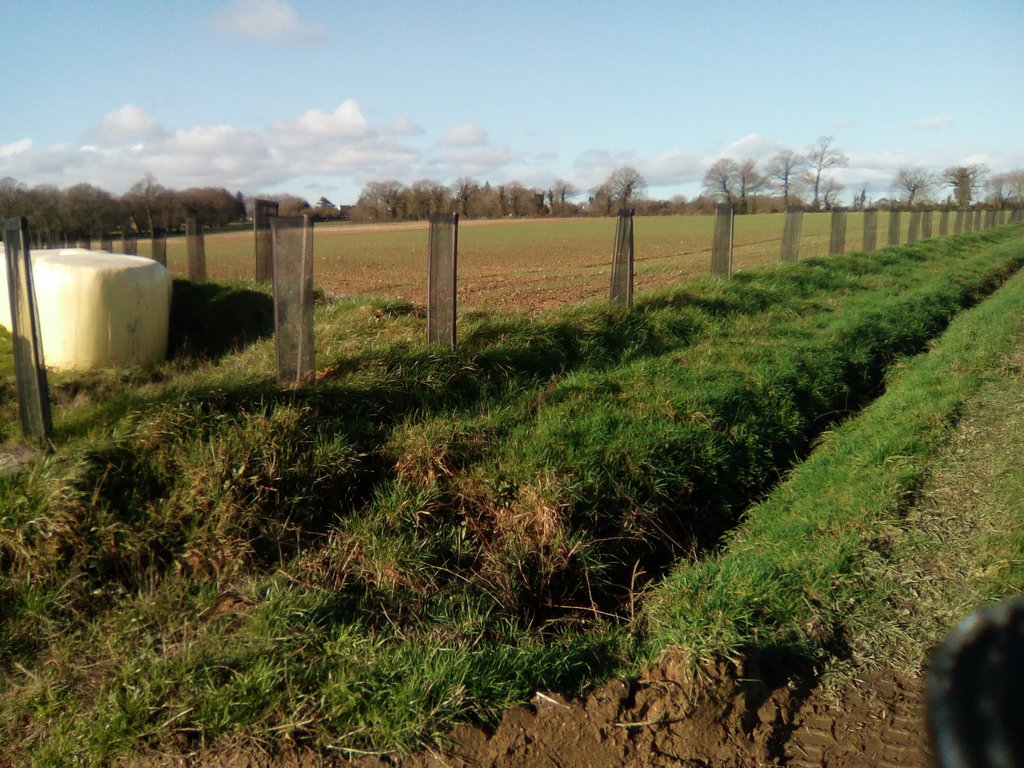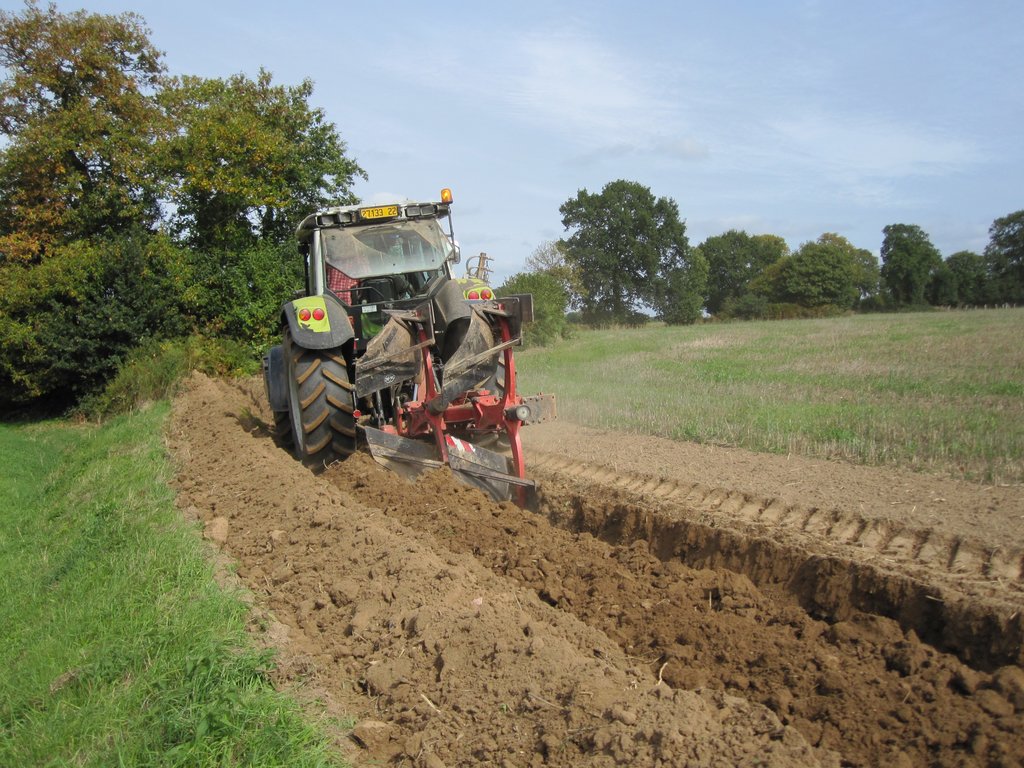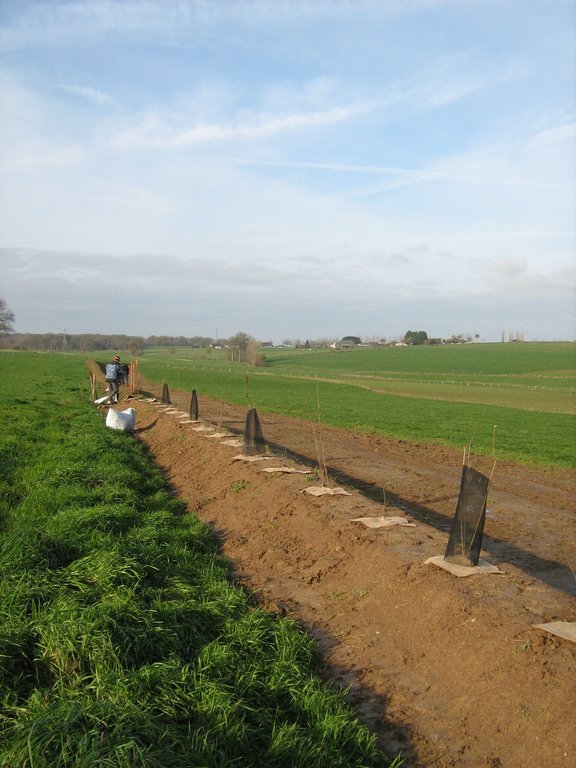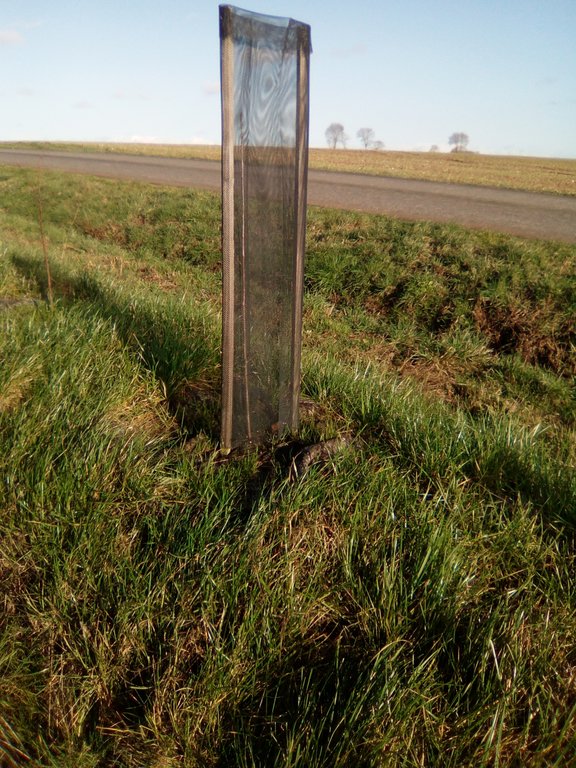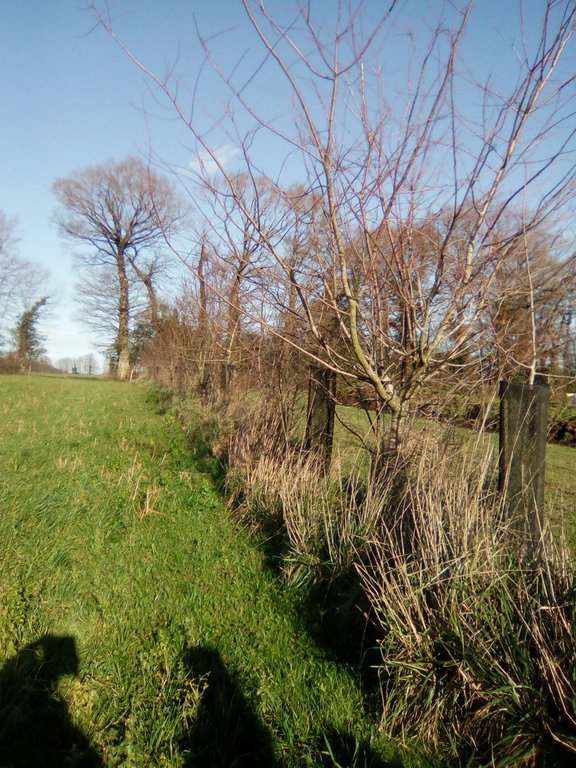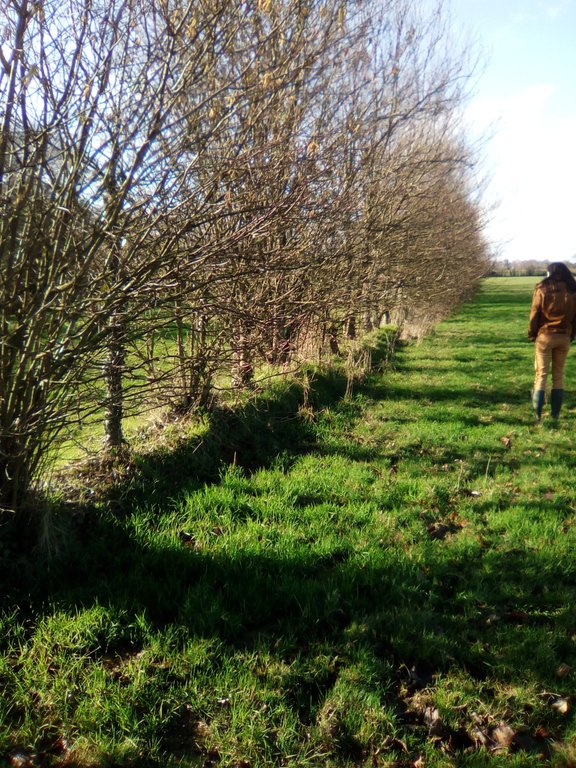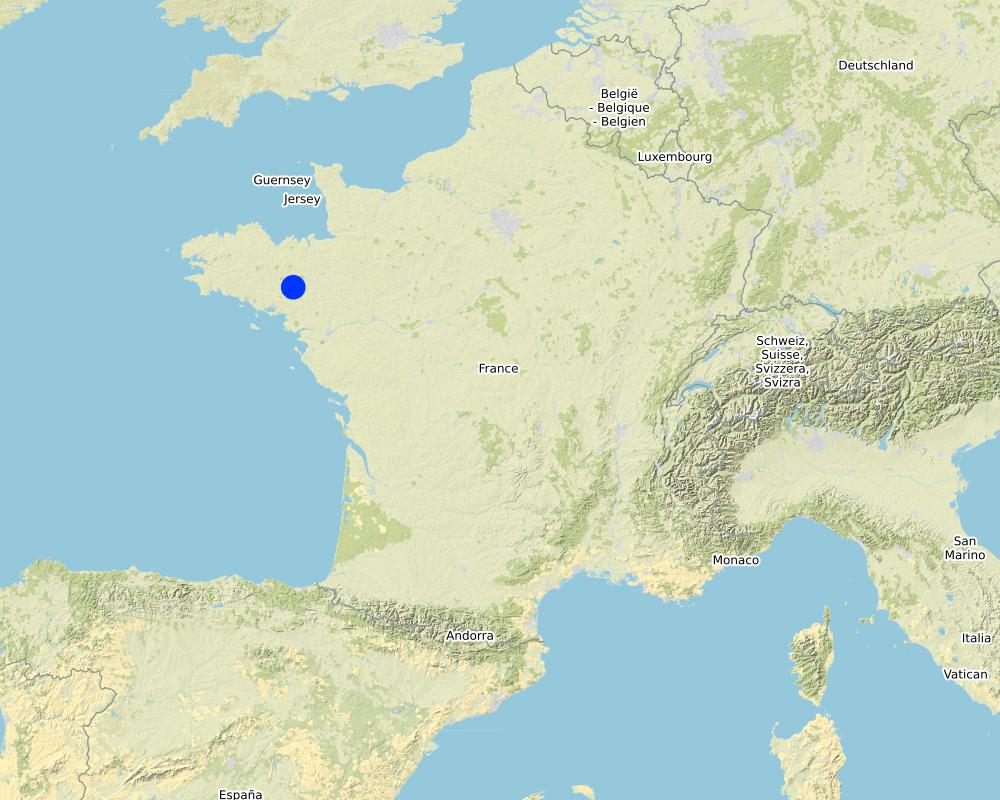Hedgerow establishment on an agro-pastoral farm for dairy cows [France]
- Creation:
- Update:
- Compiler: Alan Radbourne
- Editors: David Robinson, David Norris, Sabine Reinsch
- Reviewer: Rima Mekdaschi Studer
Bocage
technologies_5681 - France
View sections
Expand all Collapse all1. General information
1.2 Contact details of resource persons and institutions involved in the assessment and documentation of the Technology
Key resource person(s)
co-compiler:
Joubioux Christiane
Chambre Regionale D'Agriculture De Bretagne, Regional Chamber of Agriculture of Brittany
France
land user:
Danilo Noël
Danilo Noel
France
SLM specialist:
Senegas Isabelle
Chambre Regionale D'Agriculture De Bretagne, Regional Chamber of Agriculture of Brittany
France
1.3 Conditions regarding the use of data documented through WOCAT
The compiler and key resource person(s) accept the conditions regarding the use of data documented through WOCAT:
Yes
1.4 Declaration on sustainability of the described Technology
Is the Technology described here problematic with regard to land degradation, so that it cannot be declared a sustainable land management technology?
No
2. Description of the SLM Technology
2.1 Short description of the Technology
Definition of the Technology:
Low-maintenance hedgerows were established in 2003 at the ridges of an agro-pastoral farm common in Brittany to protect water quality, ensure animal well-being, maintain biodiversity, and for energy, timber and litter production.
2.2 Detailed description of the Technology
Description:
Brittany is an area in the north-west of France. Brittany’s agriculture includes well-known products such as: fish, beef, pork, poultry, vegetables and milk. The technology is applied at Danilo Noël farm, located in the commune of Mauron in Morbihan. The region has an average annual rainfall of 650-700 mm and annual temperature of around 11°C. The climate of Mauron is warm and temperate, with the farm located in the basin known as Ploërmel. ‘Bocages’ in France refer to small forests and decorative elements such as hedgerows or ornamental garden structures that border agricultural fields .
The fields of the Danilo Noël farm are grouped together in a rotational system of fodder crop and short-term pastoral leys, divided into fenced paddocks. They are located between two ‘talwegs’, with slopes of 5 or 6 %. An analysis carried out in 2000 by the water management organization ‘Grand Bassin de l'Oust’, shows that 85% of the plots are at high and medium risk of plant protection product runoff due to the slope and water run-off.
Following this evaluation of the farm, the ‘Bocage’ (small hedged pasturelands) was developed starting during the winter of 2003/2004, with the planting of 800 meters of woody features (hedges and trees) along the slopes of the talweg. Other slope plantings were carried out on the edge of the paddock in 2014/2015 (1500 meters) and 2018/2019 (1650 meters).
Earth bunds were established along the contour, either with a shovel (in 2003 and 2014) or with a forest plough (in November 2018), with hedge and tree whips (1-2 year old growth) planted 1 meter apart in single rows diectly into the shovel or plough furrow and a small amount of fertiliser and wire tree guards added. There was no irregation installed.
The technology was applied in three differnt phases combining to form one overall long-term plan. The tree species chosen for the hedgerow are local species (oak, beech, cherry, birch, myrobolan plum, chestnut, hazelnut, etc.). For the last two phases of the programs (2014 & 2018), emphasis was placed on the presence of melliferous species (for honey production) and the spread of flowering species (fruit trees, burdock, blood dogwood, medlar, etc.).
Buffering of fields with hedgerows aims to protect surface water quality and prevent land degradation by slowing surface water runoff and hence reducing soil erosion, nutrient and plant-protection product (pesticide) export and improving water infiltration into the soil and groundwater recharge. The reduction of soil erosion in turn improves productivity with a better surface cover and nutrient retention for improved plant establishment and growth. Additionally, maintenance and/or improvement of biodiverstiy can be attained as well as providing shelter for animals supports their well-being.
Major activities of the technology include: Tipping of trees (old and new) in spring/summer, soil preparation at the site of the future hedge in autumn and creation of the embankment (earth bund along the contour), tree planting over winter and laying of mulch and installation of game guards.
Benefits of the hedgerows/ shelter belts are reorganization and improvement of the field to reduce flooding, protect water quality , improve welfare of the livestock, Increase biodiversity of wildlife, including insects, birds and game. Additional honey bee forage supported the installation of an apiary (18 colonies) by a professional beekeeper in May 2019.
The only weakness of the technology in the eyes of the land owner was the extra cost/workload associated with the maintenance of the hedgerows.
The compilation of this SLM is a part of the European Interreg project FABulous Farmers which aims to reduce the reliance on external inputs by encouraging the use of methods and interventions that increase the farm’s Functional AgroBiodiversity (FAB). Visit www.fabulousfarmers.eu and www.nweurope.eu/Fabulous-Farmers for more information.
2.3 Photos of the Technology
2.5 Country/ region/ locations where the Technology has been applied and which are covered by this assessment
Country:
France
Region/ State/ Province:
Brittany
Specify the spread of the Technology:
- evenly spread over an area
If precise area is not known, indicate approximate area covered:
- 0.1-1 km2
Is/are the technology site(s) located in a permanently protected area?
No
Map
×2.6 Date of implementation
Indicate year of implementation:
2003
2.7 Introduction of the Technology
Specify how the Technology was introduced:
- through land users' innovation
- through projects/ external interventions
Comments (type of project, etc.):
The farmer since 2000 has implemented various measures aimed at sustainable agriculture on the farm, and more recently (since 2018) the farm has become a 'pilot farm' in what is now the FABulous Farmers project aiming to improve biodiversity by enhancing the production system.
3. Classification of the SLM Technology
3.1 Main purpose(s) of the Technology
- improve production
- preserve/ improve biodiversity
- adapt to climate change/ extremes and its impacts
3.2 Current land use type(s) where the Technology is applied
Land use mixed within the same land unit:
Yes
Specify mixed land use (crops/ grazing/ trees):
- Agro-pastoralism (incl. integrated crop-livestock)

Cropland
- Annual cropping
- Hedge plantation
- wheat, corn
Number of growing seasons per year:
- 1
Is intercropping practiced?
No
Is crop rotation practiced?
Yes
If yes, specify:
Rotation of 1 year wheat, 1 year corn, 1 year fallow.

Grazing land
Intensive grazing/ fodder production:
- Improved pastures
Animal type:
- cattle - dairy
Is integrated crop-livestock management practiced?
Yes
If yes, specify:
Manure intentionally used to improve crop production & crop residues are fed to animals.
Products and services:
- milk
- grassland, corn silage, wheat
Species:
cattle - dairy
Count:
62
Comments:
The hedges are planted on the periphery of the plot on embankments without interfering with the original land use.
3.3 Has land use changed due to the implementation of the Technology?
Has land use changed due to the implementation of the Technology?
- No (Continue with question 3.4)
Land use mixed within the same land unit:
No
3.4 Water supply
Water supply for the land on which the Technology is applied:
- rainfed
3.5 SLM group to which the Technology belongs
- agroforestry
- windbreak/ shelterbelt
- integrated crop-livestock management
3.6 SLM measures comprising the Technology

vegetative measures
- V1: Tree and shrub cover

structural measures
- S2: Bunds, banks
- S9: Shelters for plants and animals
3.7 Main types of land degradation addressed by the Technology

soil erosion by water
- Wt: loss of topsoil/ surface erosion
- Wo: offsite degradation effects

biological degradation
- Bh: loss of habitats

water degradation
- Hs: change in quantity of surface water
- Hp: decline of surface water quality
3.8 Prevention, reduction, or restoration of land degradation
Specify the goal of the Technology with regard to land degradation:
- prevent land degradation
4. Technical specifications, implementation activities, inputs, and costs
4.1 Technical drawing of the Technology
Technical specifications (related to technical drawing):
Creation of the embankment
- Use of the backhoe or excavator (2003/2004 and 2014/2015 developments)
- Earth removed from the field over a few metres wide - implementation by vertical compaction as the slope rises - shaping of the sides by slicing.
- Use of the forestry plough (2018/2019 development)
- 5 to 7 passes of the forestry plough to lift a 0.6 to 0.8 cm high ridge - bucket finishing for levelling .
Planting
- Choose deciduous species adapted to the environmental conditions (soil, climate) and combine several species in a hedge.
- For a honey hedge (source of pollen and nectar for bees), aim to spread out the flowering with species accessible to bees (hazelnut, burdock, black elder, blood dogwood, obier viorne, country maple, small-leaved linden, cherry, chestnut, black alder, willow...).
- Install biodegradable mulch at the foot of each plant and protection against wildlife (deer, hare, rabbit).
Author:
Isabelle Senegas
Date:
03/02/2020
Technical specifications (related to technical drawing):
Example section of planting on embankment. Single line planting of tree saplings on top of embankment, mulch mat around foot of plant, tree guard installed.
Author:
Alan Radbourne
Date:
12/02/2021
4.2 General information regarding the calculation of inputs and costs
Specify how costs and inputs were calculated:
- per Technology unit
Specify unit:
meter
Specify dimensions of unit (if relevant):
1650
other/ national currency (specify):
€
If relevant, indicate exchange rate from USD to local currency (e.g. 1 USD = 79.9 Brazilian Real): 1 USD =:
0.9
Indicate average wage cost of hired labour per day:
€10.15 on 1 January 2020, i.e. €1,539.42 monthly on the basis of the legal working week of 35 hours.
4.3 Establishment activities
| Activity | Timing (season) | |
|---|---|---|
| 1. | Tip saplings to form seedling transplants for new plants | spring-summer year 0 |
| 2. | Soil preparation at the site of the future hedge | September to October year 0 |
| 3. | Creation of the embankment using excavator or forestry plough to establish soil bunds. Vertical compaction of slopes and shaping. | September to October year 0 |
| 4. | Tree planting using several deciduous species adapted to the envionmental conditions. | December to March (year 0-1) |
| 5. | Laying of biodegradable mulch at the foot of each plant to provide nutrients and moisture retention | December to March (year 0-1) |
| 6. | Installation of game guards to protect againt wildlife (deer, hare, rabbit). | December to March (year 0-1) |
| 7. | Creation of grass strips at the foot of the slope to stabilise embankment | December to March (year 0-1) |
4.4 Costs and inputs needed for establishment
| Specify input | Unit | Quantity | Costs per Unit | Total costs per input | % of costs borne by land users | |
|---|---|---|---|---|---|---|
| Labour | Tip saplings | metre | 1650.0 | 0.35 | 577.5 | |
| Labour | Soil preparation | metre | 1650.0 | 0.8 | 1320.0 | |
| Labour | Creation of the embankment & grass strips | metre | 1650.0 | 1.8 | 2970.0 | |
| Labour | Tree planting, mulching & protection | metre | 1650.0 | 2.0 | 3300.0 | |
| Equipment | Excavator / Forest plough | metre | 1650.0 | 0.5 | 825.0 | |
| Equipment | Biodegradable mulch | metre | 1650.0 | 0.3 | 495.0 | |
| Equipment | Tree guards | metre | 1650.0 | 0.7 | 1155.0 | |
| Total costs for establishment of the Technology | 10642.5 | |||||
| Total costs for establishment of the Technology in USD | 11825.0 | |||||
Comments:
The bocage development programme is carried out by the Great Oust basin with the following financial partners: Europe, the Loire-Brittany Water Agency, the Brittany Region, the Morbihan Department. The operator will have to pay €1 (excluding tax) per linear metre.
4.5 Maintenance/ recurrent activities
| Activity | Timing/ frequency | |
|---|---|---|
| 1. | Hedge pruning and training | Winters for 10-15 years |
| 2. | Lateral pruning of the flower part of the hedges | as required between two wood harvests (with a chainsaw) |
| 3. | Slope maintenance (brush clearing and grazing) | once a year |
| 4. | Wood harvest: re-growing of out-sticking branches (Coppice and shrubs) | 15 years after planting, then every 10-15 years |
4.6 Costs and inputs needed for maintenance/ recurrent activities (per year)
| Specify input | Unit | Quantity | Costs per Unit | Total costs per input | % of costs borne by land users | |
|---|---|---|---|---|---|---|
| Labour | Hedge pruning and training | meter | 1650.0 | 0.25 | 412.5 | 100.0 |
| Equipment | Mechanical intervention: annual clearing | meter | 1650.0 | 0.35 | 577.5 | 100.0 |
| Construction material | Thermal brushcutter for landscaping and forestry work (investment to be amortized) | meter | 1650.0 | 0.6 | 990.0 | 100.0 |
| Other | Maintenance of the embankment | meter | 1650.0 | 0.15 | 247.5 | 100.0 |
| Other | od storage, chipping, transport of chips | meter | 1650.0 | 0.25 | 412.5 | 100.0 |
| Total costs for maintenance of the Technology | 2640.0 | |||||
| Total costs for maintenance of the Technology in USD | 2933.33 | |||||
4.7 Most important factors affecting the costs
Describe the most determinate factors affecting the costs:
- consistency of management
- hedge width
- Existence of outlets for wood (self-consumption, local industries, etc.)
5. Natural and human environment
5.1 Climate
Annual rainfall
- < 250 mm
- 251-500 mm
- 501-750 mm
- 751-1,000 mm
- 1,001-1,500 mm
- 1,501-2,000 mm
- 2,001-3,000 mm
- 3,001-4,000 mm
- > 4,000 mm
Specify average annual rainfall (if known), in mm:
700.00
Specifications/ comments on rainfall:
The farm is situated in the commune of Ploërmel in the Morbihan which lies in the early pedoclimatic zone.
The average annual rainfall is between 650-750 mm over the period 1971-2000.
The average annual temperature is around 11.5°C over the period 1971-2000.
Indicate the name of the reference meteorological station considered:
Ploermel
Agro-climatic zone
- sub-humid
The Ploërmel basin is the most continental of the Morbihan with colder winters, warmer summers and rainfall between 650 and 750 mm/year.
5.2 Topography
Slopes on average:
- flat (0-2%)
- gentle (3-5%)
- moderate (6-10%)
- rolling (11-15%)
- hilly (16-30%)
- steep (31-60%)
- very steep (>60%)
Landforms:
- plateau/plains
- ridges
- mountain slopes
- hill slopes
- footslopes
- valley floors
Altitudinal zone:
- 0-100 m a.s.l.
- 101-500 m a.s.l.
- 501-1,000 m a.s.l.
- 1,001-1,500 m a.s.l.
- 1,501-2,000 m a.s.l.
- 2,001-2,500 m a.s.l.
- 2,501-3,000 m a.s.l.
- 3,001-4,000 m a.s.l.
- > 4,000 m a.s.l.
Indicate if the Technology is specifically applied in:
- not relevant
Comments and further specifications on topography:
The farm is located between two talwegs. Altitudes vary between 75 and 100 m. The steepest slopes (on the southern slope) are about 6%.
5.3 Soils
Soil depth on average:
- very shallow (0-20 cm)
- shallow (21-50 cm)
- moderately deep (51-80 cm)
- deep (81-120 cm)
- very deep (> 120 cm)
Soil texture (topsoil):
- medium (loamy, silty)
Soil texture (> 20 cm below surface):
- coarse/ light (sandy)
Topsoil organic matter:
- low (<1%)
If available, attach full soil description or specify the available information, e.g. soil type, soil PH/ acidity, Cation Exchange Capacity, nitrogen, salinity etc.
The farm is located in the commune of Ploërmel in Morbihan is in the geological zone of the Briovian Shale:
- Soil mapping unit (UCS (soil map units) n°4034): Brown soils gradually leached from the plains and plateaux from locally sandstone soft shale (including deep valley bottom soils, hydromorphic from the surface, with colluvio-alluvial or alluvial input).
- Soil mapping unit (UCS (soil map units) n°4040): Mainly well-drained and poorly leached soils of cultivated plateaus from soft shale.
Source Sols de Bretagne (http://www.sols-de-bretagne.fr/)
5.4 Water availability and quality
Ground water table:
5-50 m
Availability of surface water:
good
Water quality (untreated):
poor drinking water (treatment required)
Water quality refers to:
both ground and surface water
Is water salinity a problem?
No
Is flooding of the area occurring?
No
5.5 Biodiversity
Species diversity:
- high
Habitat diversity:
- medium
Comments and further specifications on biodiversity:
Medium habitat diversity due to still young age of the hedges)
5.6 Characteristics of land users applying the Technology
Sedentary or nomadic:
- Sedentary
Market orientation of production system:
- commercial/ market
Off-farm income:
- less than 10% of all income
Relative level of wealth:
- average
Individuals or groups:
- individual/ household
Level of mechanization:
- mechanized/ motorized
Gender:
- men
Age of land users:
- middle-aged
5.7 Average area of land used by land users applying the Technology
- < 0.5 ha
- 0.5-1 ha
- 1-2 ha
- 2-5 ha
- 5-15 ha
- 15-50 ha
- 50-100 ha
- 100-500 ha
- 500-1,000 ha
- 1,000-10,000 ha
- > 10,000 ha
Is this considered small-, medium- or large-scale (referring to local context)?
- medium-scale
Comments:
The farm covers an area of 66 ha, 60 ha of which are accessible for grazing and some of which are wet.
5.8 Land ownership, land use rights, and water use rights
Land ownership:
- individual, titled
Land use rights:
- leased
Water use rights:
- open access (unorganized)
Are land use rights based on a traditional legal system?
No
5.9 Access to services and infrastructure
health:
- poor
- moderate
- good
education:
- poor
- moderate
- good
technical assistance:
- poor
- moderate
- good
employment (e.g. off-farm):
- poor
- moderate
- good
markets:
- poor
- moderate
- good
energy:
- poor
- moderate
- good
roads and transport:
- poor
- moderate
- good
drinking water and sanitation:
- poor
- moderate
- good
financial services:
- poor
- moderate
- good
6. Impacts and concluding statements
6.1 On-site impacts the Technology has shown
Socio-economic impacts
Production
crop production
Comments/ specify:
diversification of production
crop quality
Comments/ specify:
remained same
fodder production
Comments/ specify:
Shelter belts protection of crops
fodder quality
Comments/ specify:
remained same
animal production
Comments/ specify:
Well-being improves production
wood production
Comments/ specify:
New output product on land
product diversity
Comments/ specify:
Wood produced
land management
Comments/ specify:
Increased labour but more sustainable water and land management
Income and costs
expenses on agricultural inputs
Comments/ specify:
New machinery and labour costs associated with diversified management
farm income
Comments/ specify:
Increased output production
diversity of income sources
Comments/ specify:
Addition of woody crop output
workload
Comments/ specify:
Increased workload with hedgerow management
Socio-cultural impacts
land use/ water rights
recreational opportunities
Comments/ specify:
quality of life
SLM/ land degradation knowledge
Ecological impacts
Water cycle/ runoff
water quality
Comments/ specify:
Improved water quality in streams due to reduced surface run-off with hedgerow buffer strips
surface runoff
Comments/ specify:
Decreased run-off with hedgerow buffering
excess water drainage
Comments/ specify:
Rooting system reducing flooding
Soil
soil loss
Comments/ specify:
Reduced soil erosion from buffered strips
soil organic matter/ below ground C
Comments/ specify:
Hedgerow inceasing below ground C
Biodiversity: vegetation, animals
Vegetation cover
Comments/ specify:
longer cover of vegetation with hedgerows
biomass/ above ground C
Comments/ specify:
hedgerows increase above ground C
plant diversity
Comments/ specify:
Woody crops added
animal diversity
Comments/ specify:
Biodiversity increases with hedgerow habitat creation
beneficial species
Comments/ specify:
Bees, insects and birds as predators of pests
habitat diversity
Comments/ specify:
Habitat creation in hedgerows
pest/ disease control
Comments/ specify:
cultivation aids
Climate and disaster risk reduction
flood impacts
Comments/ specify:
Buffer strips & rooting systems improving infiltration
landslides/ debris flows
Comments/ specify:
Buffer strips slowing suface water flow and soil erosion
drought impacts
Comments/ specify:
Buffer strips limit water loss in drought
wind velocity
Comments/ specify:
buffer strips provide crop and animal shelter
6.2 Off-site impacts the Technology has shown
downstream flooding
Comments/ specify:
regulation of belt slope eriosion
groundwater/ river pollution
Comments/ specify:
Reduced soil, nutrient and plant protection run-off polluting watercourses
buffering/ filtering capacity
Comments/ specify:
hedges slow flow as a buffer
wind transported sediments
Comments/ specify:
shelter and sedimant capture
impact of greenhouse gases
Comments/ specify:
Intake from hedges
6.3 Exposure and sensitivity of the Technology to gradual climate change and climate-related extremes/ disasters (as perceived by land users)
Gradual climate change
Gradual climate change
| Season | increase or decrease | How does the Technology cope with it? | |
|---|---|---|---|
| annual temperature | increase | well | |
| annual rainfall | decrease | well |
Climate-related extremes (disasters)
Meteorological disasters
| How does the Technology cope with it? | |
|---|---|
| local rainstorm | very well |
Climatological disasters
| How does the Technology cope with it? | |
|---|---|
| heatwave | well |
| cold wave | moderately |
| drought | moderately |
Hydrological disasters
| How does the Technology cope with it? | |
|---|---|
| general (river) flood | well |
| landslide | moderately |
Other climate-related consequences
Other climate-related consequences
| How does the Technology cope with it? | |
|---|---|
| extended growing period | not known |
| reduced growing period | not known |
| sea level rise | moderately |
6.4 Cost-benefit analysis
How do the benefits compare with the establishment costs (from land users’ perspective)?
Short-term returns:
slightly negative
Long-term returns:
slightly positive
How do the benefits compare with the maintenance/ recurrent costs (from land users' perspective)?
Short-term returns:
slightly negative
Long-term returns:
positive
6.5 Adoption of the Technology
- 1-10%
Of all those who have adopted the Technology, how many did so spontaneously, i.e. without receiving any material incentives/ payments?
- 0-10%
Comments:
Several Breton regional programmes that aimed at improving water quality have made it possible to support bocage developments thanks to the involvement of financial partners from 2008 to 2020, as part of the wider "Breizh Bocage" programme. The remaining amount to be paid by the operator is 1€ per linear meter in the current programme.
6.6 Adaptation
Has the Technology been modified recently to adapt to changing conditions?
Yes
other (specify):
economic concern of operating system
Specify adaptation of the Technology (design, material/ species, etc.):
Due to a concern the maintenence costs would outweigh the benefit return the parcels of land have been rearranged to suit a more efficient system.
6.7 Strengths/ advantages/ opportunities of the Technology
| Strengths/ advantages/ opportunities in the land user’s view |
|---|
| Improvement and reorganisation of the plot with a reduction of wetlands. |
| Protection of the animals against bad weather and welfare of the herd. |
| Protection of water quality. |
| Increase in wildlife: insects, birds, game, etc. |
| Additional benefits of the hedges are the possibility of installing apiary (18 colonies) by a professional beekeeper in May 2019. |
| Strengths/ advantages/ opportunities in the compiler’s or other key resource person’s view |
|---|
| Hydraulic and water chemical control with combination of hedge and embankment. |
| Improvement of the landscape and the living environment favourable to the preservation of heritage and the development of tourism: hiking circuits. |
| Ecological functions with the preservation of biological diversity: "ecological corridors". |
| Economic functions with multiple outputs, such as firewood, timber, hederow crop (i.e. berries) and increased pollen source for bees |
6.8 Weaknesses/ disadvantages/ risks of the Technology and ways of overcoming them
| Weaknesses/ disadvantages/ risks in the land user’s view | How can they be overcome? |
|---|---|
| Hedge maintenance: extra cost and workload | Delegation to a specialised company. |
| Weaknesses/ disadvantages/ risks in the compiler’s or other key resource person’s view | How can they be overcome? |
|---|---|
| Time intensive upkeep (i.e. training of saplings) that maybe overlooked and thus not produce highest quality output | Outsource labour work (yet additional expense) |
| Lack of outlets for wood from hedgerows |
- self-consumption of wood: installation of plate boilers on farms, or heating networks, use of wood for animal bedding - developing territorial channels for the valorisation of wood from hedgerows |
| Need for training and support for operators | Sustainable management plan for hedges and trees on the farm, and monitoring. |
7. References and links
7.1 Methods/ sources of information
- field visits, field surveys
At the farm Noël Danilo
- interviews with land users
At the farm Noël Danilo
- compilation from reports and other existing documentation
Breih Bocage Programme (2015-2020): diagnosis actions
7.2 References to available publications
Title, author, year, ISBN:
Le guide du conseiller pour accompagner des projets agroforestiers - 2020
Available from where? Costs?
Agricultures & Territoires Chambre d’Agriculture APCA
Title, author, year, ISBN:
Le programme de plantations des haies dans la Manche - 2017
Available from where? Costs?
Chambre d’agriculture de la Manche
Title, author, year, ISBN:
Réussir une haie bocagère
Available from where? Costs?
Chambre d’agriculture de la Manche
Title, author, year, ISBN:
Guide pour des haies propices aux insectes entomophages - 2017
Available from where? Costs?
Chambre d’agriculture Pays de la Loire
Title, author, year, ISBN:
Guide pratique : produire du bois d’œuvre dans le bocage - 2015
Available from where? Costs?
Chambre d’agriculture d’Ille et Vilaine
Title, author, year, ISBN:
La haie : réservoir d’énergie - 2009
Available from where? Costs?
Chambre d’agriculture de Bretagne
Title, author, year, ISBN:
Guide technique des pratiques favorables à la biodiversité en agriculture - 2009
Available from where? Costs?
Chambre d’agriculture de l’Hérault
7.3 Links to relevant online information
Title/ description:
Le guide du conseiller pour accompagner des projets agroforestiers - 2020
URL:
https://opera-connaissances.chambres-agriculture.fr/doc_num.php?explnum_id=152429
Title/ description:
Le programme de plantations des haies dans la Manche - 2017
URL:
https://www.google.com/url?sa=t&rct=j&q=&esrc=s&source=web&cd=1&cad=rja&uact=8&ved=2ahUKEwi3wNP-5r_nAhXBxoUKHS0AC6AQFjAAegQIAxAB&url=http%3A%2F%2Fagriculture.gouv.fr%2Ftelecharger%2F84451%3Ftoken%3D72db2767fffa8628090ba53ae5b23133&usg=AOvVaw2WekHpjyhNMwQLToNVlfxk
Title/ description:
Réussir une haie bocagère
URL:
https://manche.chambres-agriculture.fr/environnement/reussir-une-haie-bocagere/
Title/ description:
Guide pour des haies propices aux insectes entomophages - 2017
URL:
https://pays-de-la-loire.chambres-agriculture.fr/publications/publications-des-pays-de-la-loire/detail-de-la-publication/actualites/guide-pour-des-haies-propices-aux-insectes-entomophages-grandes-cultures/
Title/ description:
Produire du bois d’œuvre dans le bocage -2015
URL:
https://afac-agroforesteries.fr/guide-pratique-produire-du-bois-doeuvre-dans-le-bocage/
Title/ description:
La haie : réservoir d’énergie - 2009
URL:
https://www.bioenergie-promotion.fr/wp-content/uploads/2011/01/La-haie-réservoir-énergie-Pôle-agronomie-Bretagne-2009.pdf
Title/ description:
Guide technique des pratiques favorables à la biodiversité en agriculture - 2009
URL:
https://www.chasse-nature-occitanie.fr/agriculture-et-territoire/documents/Agrifaune-guide-tech-biodivers.pdf
7.4 General comments
none
Links and modules
Expand all Collapse allLinks
No links
Modules
No modules


